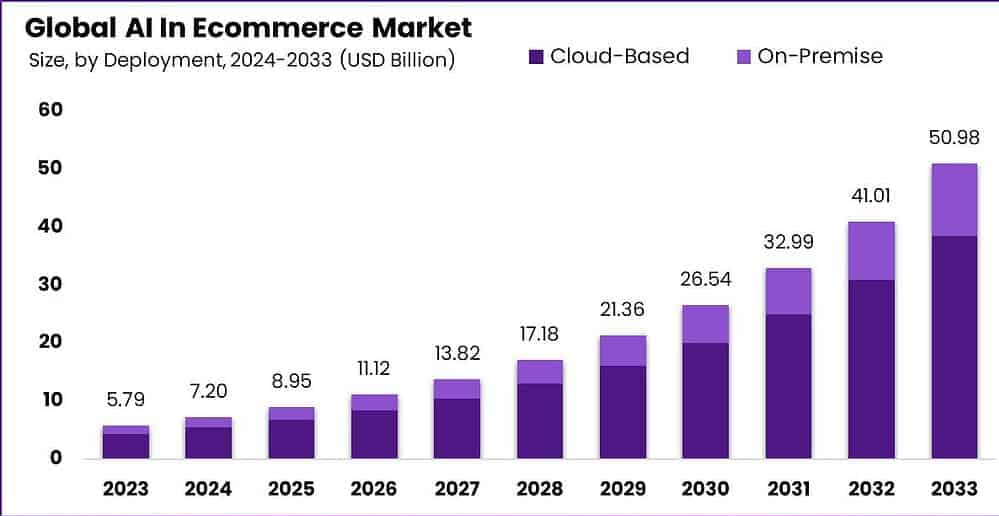Introduction
The Global AI in Ecommerce Market is set to surge from USD 5.79 billion in 2023 to USD 50.98 billion by 2033, with a CAGR of 24.3%. AI transforms ecommerce by enabling personalized shopping, optimizing operations, and enhancing customer engagement. Driven by booming online retail, AI advancements, and data-driven strategies, the market reshapes global commerce. North America led with a 38.6% share in 2023, generating USD 2.23 billion. By leveraging machine learning, chatbots, and analytics, AI empowers retailers to boost sales and efficiency, redefining the future of ecommerce worldwide.
Key Takeaways
-
Market Surge: From USD 5.79 billion in 2023 to USD 50.98 billion by 2033, at a 24.3% CAGR.
-
Growth Drivers: Online shopping growth, AI innovation, and analytics adoption.
-
Dominant Segments: Cloud deployment, software, and retail lead.
-
Challenges: High costs, privacy concerns, and skill shortages.
-
Regional Outlook: North America holds 38.6% share; Asia-Pacific grows fastest.
Deployment Analysis
Deployment types include cloud and on-premises. Cloud captured a 72% share in 2023, driven by its scalability, cost-efficiency, and seamless integration. On-premises, growing at a 21% CAGR, is favored for data security by large retailers. Cloud dominates for its flexibility, enabling real-time AI updates, while on-premises drives growth in industries requiring stringent data control, supporting tailored AI solutions for enhanced ecommerce efficiency and customer engagement.
Component Analysis
Components include software, hardware, and services. Software held a 62% share in 2023, fueled by demand for AI tools like recommendation systems and chatbots. Services, growing at a 27% CAGR, offer consulting and integration expertise. Hardware supports AI processing needs. Software leads for its core AI functionalities, while services drive growth by enabling smooth AI adoption, optimizing ecommerce operations and customer experiences.
End User Analysis
End users include retail, fashion, electronics, and others. Retail dominated with a 52% share in 2023, leveraging AI for personalization and inventory optimization. Fashion, growing at a 29% CAGR, uses AI for trend forecasting and virtual try-ons. Electronics focuses on automated customer support. Retail leads due to broad AI adoption, while fashion drives growth, fueled by innovative, customer-centric ecommerce solutions.
Market Segmentation
-
By Deployment: Cloud, On-Premises
-
By Component: Software, Hardware, Services
-
By End User: Retail, Fashion, Electronics, Others
-
By Technology: Machine Learning, Natural Language Processing, Computer Vision
-
By Region: North America, Asia-Pacific, Europe, Latin America, Middle East & Africa
Restraints
High implementation costs and integration challenges hinder AI adoption, particularly for SMEs. Data privacy concerns and regulatory compliance pose risks. Skill shortages in AI expertise limit progress. Addressing these requires affordable solutions, robust privacy measures, and workforce training to ensure scalable AI integration in ecommerce ecosystems.
SWOT Analysis
-
Strengths: Personalized experiences, operational efficiency, and scalability.
-
Weaknesses: High costs, privacy risks, and skill gaps.
-
Opportunities: Ecommerce growth, AI advancements, and emerging markets.
-
Threats: Regulatory complexities and cybersecurity vulnerabilities. This analysis highlights AI’s potential to transform ecommerce while emphasizing cost and privacy challenges.
Trends and Developments
Trends include AI-driven chatbots, predictive analytics, and visual search technologies. Investments, like Google’s $270 million AI fund in 2023, spur innovation. Partnerships, such as Salesforce’s retail collaborations, accelerate adoption. Hyper-personalization and sustainable ecommerce gain traction. These trends position AI as a driver of seamless, customer-focused online retail, emphasizing innovation and scalability across global markets.
Key Player Analysis
Major players include Amazon, Google, IBM, Microsoft, and Salesforce. Amazon and Google lead with advanced recommendation and search AI. IBM excels in consulting services, while Microsoft and Salesforce dominate cloud-based AI solutions. Strategic alliances, like Salesforce’s partnerships, and acquisitions strengthen market positions, shaping ecommerce with innovative AI tools.
Conclusion
The Global AI in Ecommerce Market, growing from USD 5.79 billion in 2023 to USD 50.98 billion by 2033 at a 24.3% CAGR, is reshaping retail. Despite cost and privacy hurdles, AI drives personalization and efficiency. Investments and training will ensure scalable, transformative growth.
Deployment types include cloud and on-premises. Cloud captured a 72% share in 2023, driven by its scalability, cost-efficiency, and seamless integration. On-premises, growing at a 21% CAGR, is favored for data security by large retailers. Cloud dominates for its flexibility, enabling real-time AI updates, while on-premises drives growth in industries requiring stringent data control, supporting tailored AI solutions for enhanced ecommerce efficiency and customer engagement.
- Revolutionizing Retail: Global AI in Ecommerce Market 2024-2033
- Deployment types include cloud and on-premises. Cloud captured a 72% share in 2023, driven by its scalability, cost-efficiency, and seamless integration. On-premises, growing at a 21% CAGR, is favored for data security by large retailers. Cloud dominates for its flexibility, enabling real-time AI updates, while on-premises drives growth in industries requiring stringent data control, supporting tailored AI solutions for enhanced ecommerce efficiency and customer engagement.
- consumer,
Related posts:
 Unlocking Marketing Success with a Netherlands Email List: Your Ultimate Guide
Unlocking Marketing Success with a Netherlands Email List: Your Ultimate Guide
 The Rise of Flavoured Yogurt: Taste, Health, and Innovation in Every Spoonful
The Rise of Flavoured Yogurt: Taste, Health, and Innovation in Every Spoonful
 Discover the Charm of High Rise Apartments in Oakville, Ontario with Altrahomes
Discover the Charm of High Rise Apartments in Oakville, Ontario with Altrahomes
 How to Order a Cheap Dissertation in the UK: Step-by-Step Guide for Students
How to Order a Cheap Dissertation in the UK: Step-by-Step Guide for Students







